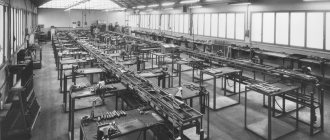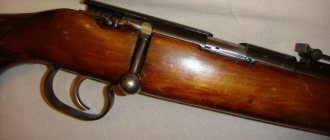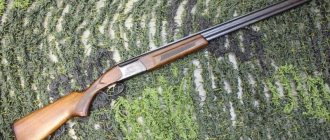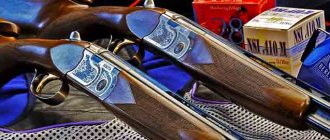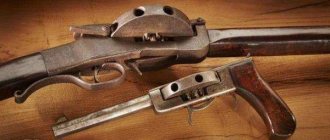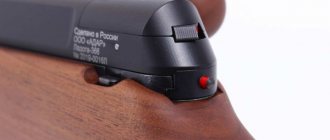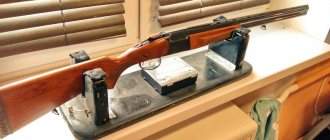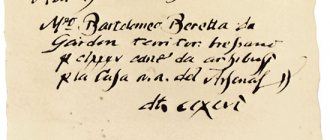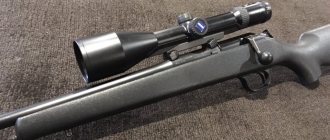History of double-barreled shotguns Regis Darne (Regis Darne)
Although there is now a very rich assortment of products on the arms market, guns are still very clearly divided into decorative and commercial, sporting and. etc. But there are types of guns that are difficult to categorize. Such a gun is a double-barreled gun for hunting with a pointer, made by Regis Darn, a gunsmith from France.
In 1881, Regis Darn created a company dedicated to the production of weapons in the city of Saint-Etienne. Since Regis Darn was very gifted and had a good imagination, production was launched very productively and quickly.
The arms company Darna began production with military machine guns. When the First World War began, the French army could not decide on a supplier of aircraft machine guns. The order for machine guns was received by Regis Darn. The machine guns produced by his company were so good that they were produced before the start of World War II.
Even taking into account the fact that the company provided the army with weapons, it did not employ very many people. The 350 people who make up the company’s team produced not only army orders, but also excellent guns for hunting. Hunting rifles were cheap, but very original in design features. For his creation of fixed barrels for double-barreled shotguns, which had a sliding bolt box, Darn received an award at the 1900 International Arms Exhibition.
In 1939, Regis Darn died. The company operated until 1968. Since weapon preferences and requirements were constantly changing, the surrounding world was changing completely, and at the same time the French colonies no longer belonged to France, the country’s economy began to decline significantly. The company closed due to lack of finance.
The history of the company and the history of the invention of barrels might have been completed, but the company’s employees were truly “fanatics” of their work. Thus, Paul Bruchet, who was the head of one of the company’s workshops, bought up the weapons remaining after bankruptcy and was able to debug the production of original and unique double-barreled hunting shotguns. By the way, Bruchet launched production in 1981, just one hundred years after the opening of Regis Darnat’s company.
Four years later, the Darn brand, or to be precise, the right to use the brand, was entirely given to Bruchet. Hervé Bruchet, the son of Paul Bruchet, took over the management of the arms factory in 1995 and is now the head of the company.
But you need to go back a little in time to learn about the development of double-barreled guns, thanks to which the Darn brand became famous.
Already in 1881, Regis Darn designed the first weapons with fixed barrels. It was a kind of hammer-fired double-barreled shotgun. The design of the weapon was very simple, so the price was low. Over the course of 13 years, various modernizing solutions have been added to the design of the weapon. Over the years, approximately 15 thousand guns were sold.
The first double-barreled shotgun, which used a massive bolt and internal hammers, was released in 1891. Three years later, ejectors began to be installed on this model.
The final version of the bolt box, which could slide in the grooves of the base, was created in 1898. The principle was invented so well that it is still used in production today. The box design contains a minimum number of parts. Various grooves, holes and other things that gunsmiths love so much are not used in Darnovsky double-barreled shotguns. All this makes it possible to produce weapons cheaply and create a design with maximum reliability.
The latest type of Darnovsky-made double-barreled guns contains five main elements - the fore-end, the stock, the bolt box, the base and the barrels. The system is installed around a base embedded in the stock. The stock is responsible for all the advantages of Darna weapons.
The breech area of the barrels is secured with a steel coupling. The coupling is a single unit with the under-barrel rear hook. The entire length of weapon barrels is soldered using soft solder.
The length of the barrels in Darna weapons ranges from 600 to 720 millimeters. The length depends on the client's wishes. In the standard production version, a full choke is made in the left barrel, and a half choke is made in the right barrel. In some examples, the right barrel is made with a cylindrical drilling, but this is at the discretion of the buyer.
In order to remove the barrel while cleaning the weapon, the stopper is pressed out, and after that you need to hit the butt plate of the gun with your palm. From such actions the base moves away from the couplings with hooks. The stopper is made either push-button or lever, it all depends on the series of weapons being produced. The gun is assembled by installing the barrels, with massive hooks, into the base and securing them with a stopper.
For your information, the distance between the under-barrel hooks in weapons designed by Darn is 3 times greater than in break-action rifles. Thanks to this indicator, excellent immobility of the barrels in these guns is achieved.
The model of a double-barreled weapon, in which fixed barrels were used, was produced by the company since 1989 and was produced without any changes for ten years. In 1909, the company decided to launch the production of these weapons in three types. View R, P and V – The V model featured convergent seals. With the help of this type of seal, the chambers were sealed, which in turn prevented the penetration of powder gases from there. The locking lever in this type of model production was larger than in the R model. The R weapon model was presented as an elite gun, with the best external finish and excellent production quality, although in all weapon assemblies the production quality at the Darn company was excellent. There are practically no other special differences in the models.
An attempt to distinguish these models by looking closely at the quality of the finish will most likely end in failure. For example, the cheapest of the models, Model R, can be made using simple wood, or very high-quality walnut wood can be used. There may be no ornament on the model, or it may be made in the form of very beautiful and complex engraving.
Weapon models R and V are still in production. And now the elite model P can most likely be found only in the private collections of gunsmiths, since since 1965 this model has ceased to be produced.
Like all high-quality and popular things, Darn fixed-barrel weapons are subject to counterfeiting. To be able to distinguish the original from the handicraft, you need to make sure that there is a factory mark. The stamp is on the bolt lever and barrel pads. The stamp contains information about the modification of the weapon. For example, the R 13 weapon modification has three marks, since the number ten is added to the number of marks on the weapon.
Darn's guns have amazing balance characteristics. The designers were able to make a light and very convenient weapon, and the immobility of the barrels helped them with this. During the production of Darn double-barrels, no unusual materials are used. The design of the weapon made it possible to achieve an average weight of 2.8 kilograms, in 12-gauge barrels. That is, the smaller the caliber, the lighter the weapon. If a weapon buyer wants to lighten a weapon by about 200 grams, then modern materials will be used in production.
Original guns
Over the several centuries that have elapsed since the invention of gunpowder and the advent of firearms, man has more than once had the opportunity to show ingenuity. Gunsmiths have created countless original guns and carbines. Original guns differ from the original ones in their non-standard approach to loading the gun and mechanism.
However, most of these weapons, which do not fit into the now classic schemes - the so-called “systems” - have now been forgotten. Nevertheless, some of its types are still offered to customers and have their enthusiastic fans.
The Bretton shotguns produced by Saint-Etienne are the lightest in the world because all their metal parts are made of aluminum. The “Baby” model (pictured below) weighs no more than 2.3 kg. It has been produced for over fifty years, but currently only in 12 gauge. The barrels of all three models are screwed into the bolt housing and are therefore removable. Their lengths are 61, 65 and 70 cm, chokes of all commonly used sizes. In the front part, the barrels of the Bretton series shotguns are tightened with a clamp on which the front sight is mounted. The forend moves in the longitudinal plane along with the barrels and is fixed on the breech of the bolt with a metal latch bar.
BRETTON shotguns
The action of the Baby model consists of two parts; they are connected to each other by two
strong retractable pins on which the extractors are attached. The bolt is locked by turning the lever located on the side, while the eccentric connected to it enters the grooves of the pins and locks them. Two modifications of this gun are available: with a blued or engraved bolt box.
The “Fay-Play” model from the “Bretton” series was created on the basis of the “Baby” and has the same principle of operation. Nevertheless, this gun has flip-up barrels, and its pins, shorter than those of the previous model, fit into sockets located in the end part of the bolt block. Both halves of the breech are connected to each other by strong side plates of the bolt box, as a result of which this model is approximately 100 g heavier than the Baby. There is also a modification with a blued breech (p. 90, picture above).
The most famous of the non-breakable guns is undoubtedly the Darn. This model has become widespread, and even hunters who have never held it in their hands nevertheless recognize this weapon, named after its creator. The first bolt-action gun of this type was made in 1894 at the Darna factory in Saint-Etienne. This enterprise employed up to 350 people and carried out many military orders. In particular, Darn invented an aircraft machine gun that could fire through the rotating propeller of an aircraft. Currently, the artisanal production of Darn guns, the reliability of which has long been in need of proof, is carried out by Paul Bruchet and his son.
A modification of the Darn shotgun with rifled barrels 60 cm long and an open sighting rib for raid hunting. The proposed option is designed to use 8x57 JRS and 9.3x74 I, which is perfect for round-up hunting of large game. Weight - from 3.4 kg.
A cross-section of the Darn gun, which clearly shows the main parts and the operating principle of its mechanism.
"Darn", modification of "I". The cheapest of the guns offered by Paul Bruchet. Has a small barrel locking lever. Same barrel lengths, calibers and rib as the next model.
"Darn", modification "V". An expensive gun with a large barrel locking lever. Produced in all standard calibers, from 12 to 410. The length of the barrels is from 60 to 76 cm, the aiming bar is straight or beveled (“feather”). Engraving at customer's choice.
A small company from Saint-Etienne produces hunting and small arms of the simplest design. In addition, the guns manufactured here are among the cheapest and most durable. Unlike other classic guns, RAF-manufactured guns do not automatically cock the hammer when the bolt is opened. Having loaded a gun or carbine, the hunter himself must cock the triggers, pulling them back using spring-loaded round handles located on the side of the receiver. This operation does not require much effort, but it is important not to forget to do it. In cases where you have to reload the gun or when your fingers are numb from the cold, this is not very convenient...
Double express carabiner. Caliber 9.3x74R and 7x65R.
Combination shotgun. Barrel caliber 20 and 5.6×50. From a smooth barrel you can shoot small game, from a rifled barrel you can shoot a roe deer from an ambush. Other combination shotguns are available with the 20/.22 Hornet, 410/.22 Hornet, 4 x 10/22 Magnum and 410/22 LR combinations. Rifled barrels are good for hunting small predators.
A small double-barreled shotgun. Both barrels are 410 caliber. Modifications with 12 and 14 mm caliber barrels are also offered, designed for short-range shooting at larks and blackbirds.
